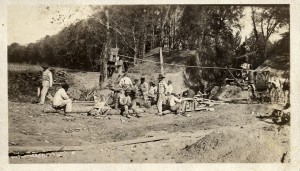Colorlines is one of my favorite publications. I really like the fact that they unabashedly cover issues of race and racism in the U.S. They are unique in this. Today, Colorlines published a piece titled From Attica to Pelican Bay: A Brief History of Organized Prison Rebellions . Here’s how Attica was discussed in the piece:
Attica, New York (1971)
Began as a protest of the death of black radical activist prisoner George Jackson at the hands of a San Quentin prison guard. Quickly turned from a peaceful demonstration to a riot. Approx 1,000 of the prison’s 2,200 inmates rebelled, seizing control of the facility and taking 33 staff hostage. Authorities agreed to 28 of the prisoners’ demands, which included creating a committee of politicians and journalists to oversee the negotiation talks about better living conditions. The end came when law enforcement officials opened fire, leaving 29 inmates and 10 hostages dead. A class-action suit filed later in the 1970s was finally settled in 2000, when a federal judge ordered New York state to pay $8 million to the surviving inmates.
Sigh… Look it’s true that if you only have a few sentences to describe anything, you will necessarily have to generalize. However, one of my biggest pet peeves involves the way that we often explain historical events by pointing to a single catalyzing moment. In the case of Attica, there were actually a series of events that led to the ultimate revolt in September 1971.
George Jackson‘s death was one in a line of grievances that contributed to creating the climate where a prison revolt was more likely to happen at Attica than not. Yet it was not “the” trigger. It was a contributing factor and a moment that provided a platform for the organizing that was already happening at the prison.
Between the late 1960s and the early 1980s, there were over three hundred prison “riots” across the U.S., Attica was the best known among these. These uprisings became symbolic of the larger civil unrest that had engulfed the country. As Foucault has observed, because they are total institutions with strong control over individuals’ lives, prisons will always engender resistance.
The official report of the New York State Special Commission on Attica also commonly referred to as the McKay Commission report provides us with the most extensive documentation of what happened before, during and after the Attica Rebellion. The preface of the official report suggested that “Attica is every prison; and every prison is Attica” to make the case that there was nothing unique about Attica that led to the revolt. In other words, the Attica uprising could have happened in any prison across the U.S.
From September 9 to 13, 1971, prisoners took control of the Attica Correctional Facility. They made a series of demands to prison administrators and held about 40 people as hostages. After four days of fruitless negotiations, Nelson Rockefeller ordered that the prison be retaken; 39 people were killed in a 15 minute assault by state police. The New York State Special Commission on Attica appointed to investigate the uprising suggested that: “With the exception of Indian massacres in the late 19th century, the State Police assault which ended the four-day prison uprising was the bloodiest one-day encounter between Americans since the Civil War.”
Antecedents to the Attica Revolt
The McKay Commission suggested that during the summer of 1971 prisoners at Attica launched a sociology class that was led by their peers. This was preceded by the formation of several study and discussion groups led by prisoners who had affiliations with the Nation of Islam, the Black Panther Party, the Young Lords and the Five Percenters. Carl Jones-EL, one of the founders of the Attica Liberation Faction explains:
“The education department, the school system that they have, it only goes so far, far as trying to give a man an education. We more or less have to educate ourselves. When we came here [Attica] we knew the conditions and we felt that people should come together and get a better understanding of the conditions here, what was being did to them by the administration. So behind this we would hold meetings in the yard. We’d hold open house and whoever wanted to come and listen to our political ideology were welcome. We didn’t bar anyone. This was frowned upon by the institution and they would break it up. If we congregated too big, this wasn’t allowed. In order to reach everyone, we had to set up some sort of communications. We had to get along with the different factions here: the Muslims, the Fiver Per-centers, and all the other factions to become one solid movement, rather than just be separate parts here trying to accomplish the same things, better conditions for the inmates .”
These informal gatherings provided a forum for prisoners to debate and discuss the social and political issues of the day. The McKay Commission found that these prisoner-created spaces politicized and radicalized inmates and contributed to a series of protests in the summer of 1971.
In June 1971, five Attica Prisoners established the Attica Liberation Faction (ALF). The five founders were Frank Lott (who took on the title of Chairman), Donald Noble, Carl Jones-El, Herbert X. Blyden, and Peter Butler. Carl Jones-EL suggested that the ALF was founded:
“to try to bring about some change in the conditions of Attica. We started teaching political ideology to ourselves. We read Marx, Lenin, Trotsky, Malcolm X, de Bois, Frederick Douglass and a lot of others. We tried a reform program on ourselves first before we started making petitions and so forth. We would hold political classes on weekends and point out that certain conditions were taking place and the money that was being made even though we weren’t getting the benefits .”
Lee Bernstein (2010) provides some background about the founders of the Attica Liberation Faction:
“These five – Frank Lott, Herbert X. Blyden, Donald Noble, Carl Jones-El, and Peter Butler – were among the most experienced activists in Attica. Blyden had participated in a rebellion at the Tombs prison in New York City the previous year, helping to write the rebels’ list of demands. Others had been involved in a sit-down strike at Auburn prison. Blyden is credited with demanding that the prisoners be transported to a nonimperialist country as a condition of ending the takeover. While deemed impractical by one of the outside observers, this demand grew logically from the political education many inmates received while in prison. Blyden and Jones served on the negotiating committee during the takeover. Blyden was a member of Attica’s Nation of Islam community, and Carl Jones-El and Donald Noble were members of the prison’s Moorish Science community. (Bernstein, p.67-68)”
In July 1971, the Attica Liberation Faction presented a list of 27 demands to Commissioner of Corrections Russell Oswald and Governor Nelson Rockefeller. This list of demands was based on the Folsom Prisoners’ Manifesto which had been crafted in support of a November 1970 prisoner strike in California. Carl Jones-EL offered this description of the genesis of the manifesto and the prisoner’s motivations:
“We wanted to do things, let’s say, diplomatically. We were seeking reform. Although, many were not in favor of reform, because they didn’t believe that the people would listen. So, five of us had gotten together. This is how we started. We met in the yard and we’d draw up drafts as to proposals we should make. And we sought support from the entire population, the four different blocks. And the only way we could accomplish this was that by us not being able to see everyone in different blocks, we, more or less, had to get on the traveling list. In other words, if you were a baseball, a football, a softball official, and you were in a position to travel and get around to different blocks. So we did this. One of us would go to different blocks, and there we would set up an educational program, and bring to their attention what the manifesto was going to be about. So we got a lot of support on this. Then we moved on it. Everyone was not in favor of signing their names to it though, because they didn’t want to spotlight themselves. So five of us did .”
Commissioner Oswald did not act on the demands instead the warden of Attica, Vincent Mancusi, responded “by increasing the frequency of cell searches, censoring all references to prison conditions from news sources, and announcing that there would be no prizes awarded to the winners of the upcoming Labor Day sporting competitions (Bernstein, p. 69).”
Donald Noble, a member of the Attica Liberation Faction, explains what the prisoners hoped to accomplish through the Manifesto:
“Well, I’m one of the men whose name was on the manifesto [that] was submitted to Oswald. We submitted a manifesto, 28 demands, to Oswald in July. We also submitted one to Rockefeller. We also submitted one to Shirley Chilsolm. We also submitted one to Arthur Eve and different other legislative people and lawyers and so forth. You know, we got a beautiful reply back from Oswald, think it was sometime in August. He acknowledged our letter and so forth, and he was enthused about the way the manifesto was drawn up, because this was more or less coincide with his ideas. And he stated that he is for all these here changes that we talked about, because he sees that they are needed, but to give him time. And, everybody went along with him, because a lot of us have had dealings with Oswald for years, coming back and forth while he’s sitting on the parole board. Like there was things that all he had to do was more or less get in touch with the warden here that would have gone into effect. And these things more or less didn’t take place. […] He said he was going to look into these things, but they would take time. So he came here. He made a speech, but the speech he made, a lot of people didn’t like it because he talked about long range things. But people wanted to know what he gonna do about the problem what exists here .”
When George Jackson was killed by correctional officers at San Quentin Prison in August 1971, his killing sparked protests including work stoppages at prisons across the U.S. At Attica, the different prisoner factions, that had previously found it difficult to unify in order to strengthen the likelihood that their demands would be enacted, were mobilized by the killing of Jackson. Donald Noble, one of the founders of the Attica Liberation Faction, explained it this way:
“What really solidified things was George Jackson’s death. This had a reaction on the people, one that we were trying to accomplish all along, to bring the people together. We thought, ‘How can we pay tribute to George Jackson?’ because a lot of us idolized him and things that he was doing and things that he was exposing about the system. So, we decided that we would have a silent fast that whole day in honor of him. We would wear black armbands. No one was to eat anything that whole day. We noted that if the people could come together for this, then they could come together for other things .”
The next week saw another peaceful protest through a takeover of the hospital area by prisoners. It was actually a mundane altercation between two prisoners and some guards on September 8th 1971 that finally precipitated the revolt on the next day.
The Attica prison uprising was the most dramatic and deadly of the post-Jackson killing protests. However the seeds of the revolt had been sown way before Jackson’s death.




